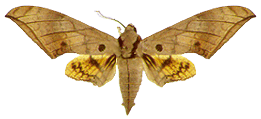|
Ambulyx substrigilis Westwood
Sphinx (Ambulyx) substrigilis Westwood, 1848, Cab. Orient. Ent., p. 61.
Oxyambulyx substrigilis Westwood; Rothschild & Jordan, 1903: 201.
Oxyambulyx brooksi Clark, 1923, Proc. New Engl. Zool. Club, 8: 52.
Oxyambulyx substrigilis cana Gehlen, 1940, Ent. Zeitschr., 54: 140.
|

Ambulyx substrigilis
♂
(.65
natural size)
|
Diagnosis. This species could be confused with pryeri and clavata but has
a stronger subtornal marking and a slightly more variegated ground colour
to the forewing; the submarginal line is usually more strongly curved over
its anterior half. The intensity of the hindwing banding is intermediate
between that of pryeri and clavata. In the male genitalia the ventral
process of the harpe is broad, rounded, compared with acute in pryeri and
clavata.
Taxonomic notes. Sundanian material is referable to ssp. brooksi Clark.
Geographical range. Indian subregion to Peninsular Malaysia, Sumatra,
Borneo.
Habitat preference. Harman (1981) recorded the species from lowland forest
in Brunei, but the few specimens taken on G. Kinabalu and G. Mulu were
from between 1000-2000m.
Biology. The larva of the S. Indian race was illustrated by Bell &
Scott (1937). It is bright green above, greyish green below. The oblique
stripes are weak except that associated with the anal horn. This stripe is
white; there are white patches marking the position of the more anterior
stripes subdorsally that tend to coalesce towards the anterior to form a
subdorsal line on the thorax.
Recorded host-plants (Bell & Scott, 1937; Dupont & Roepke, 1941)
are: Dipterocarpus (Dipterocarpaceae); Lagerstroemia (Lythraceae);
Aglaia
(Meliaceae).
<<Back
>>Forward <<Return
to Contents page
|

